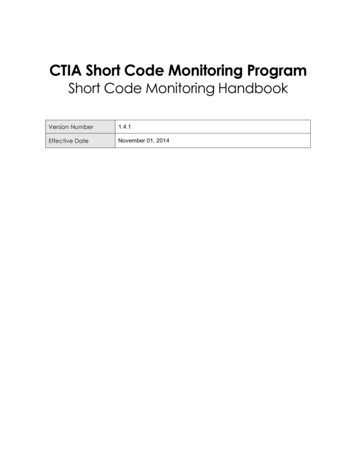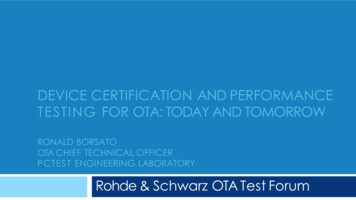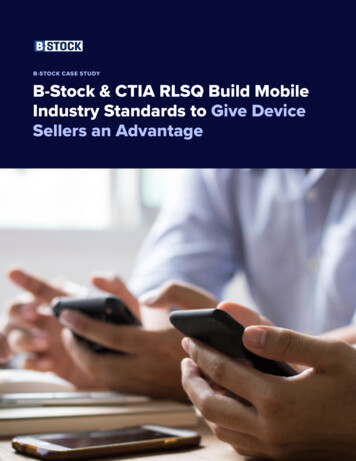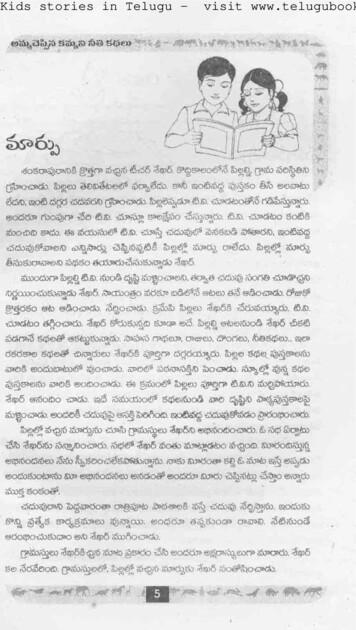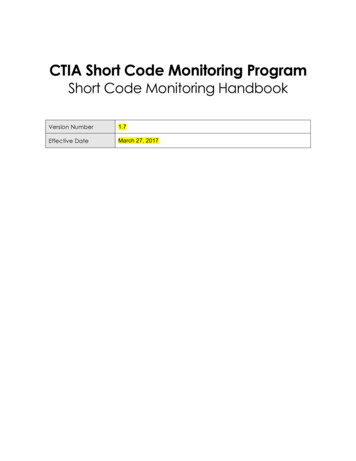
Transcription
CTIA Short Code Monitoring ProgramShort Code Monitoring HandbookVersion Number1.7Effective DateMarch 27, 2017
TABLE OF CONTENTSVERSION HISTORY . 1INTRODUCTION. 2About This Handbook . 2References . 2COMPLIANCE FRAMEWORK . 3Universal Compliance Principles . 3A.1Guiding Principles . 3A.2Choice and Consent . 3A.2.01Unsolicited Messages . 3A.2.02Marketing Context. 3A.2.03Opt-In . 3A.2.04Opt-Out . 4A.3Customer Care . 4A.4Program Content. 5A.4.01Unapproved or Illicit Content . 5A.4.02Controlled Substances . 5A.4.03Sweepstakes and Contests . 5A.4.04Content Delivery . 5A.5Privacy Policy and Terms and Conditions . 5A.6Program Name and Product Description . 6A.7Program Records and Functionality . 6A.7.01Customer Records . 6A.7.02MO Message Processing . 6Use Cases . 6A.8Single-Message Programs . 6A.9Recurring-Messages Programs . 7A.10 Machine-to-Machine Programs . 9A.11 Premium Rate Political Donation Programs . 9A.12 Premium Rate Charitable Donation Programs . 9A.13 Free-to-End-User Programs . 9A.14 MMS Programs. 9A.15 Interactive Customer Care Chat Programs . 9ii
Carrier Onboarding . 9IN-MARKET MONITORING GUIDE . 11Compliance Audits . 11A.16 Audit Notices . 11A.17 Schedule . 11A.18 Severity Levels . 11A.19 CTIA Compliance Care Team Communication . 12A.20 Retests . 12A.21 Appeals . 12AUDIT STANDARDS GUIDE . 13AUDIT STANDARDS . 14Single-Message Programs . 14A.22 Single-Message Program Advertising Audit Standards . 14A.23 Single-Message Program Message Flow Audit Standards . 14Recurring-Messages Programs . 15A.24 Recurring-Messages Program Advertising Audit Standards . 15A.25 Recurring-Messages Program Message Flow Audit Standards. 15A.26 Machine-to-Machine Program Audit Standards . 16APPENDIX A: SAMPLE COMPLIANT SINGLE-MESSAGE PROGRAM. 17APPENDIX B: SAMPLE COMPLIANT RECURRING-MESSAGES PROGRAM . 20APPENDIX C: COMMON TERMS . 24iii
VERSION HISTORY1VersionRelease DateDetails1.5.2October 1, 2015The CTIA Short Code Monitoring Handbook was updated with thefollowing:§Guiding Principles section;§Unsolicited messages definition update;§Recurring-messages short code program opt-in guideline update;§Program name and product description guidelines;§Free-to-end-user program requirements; and§Appendix C: Common Terms.1.6July 15, 2016The CTIA Short Code Monitoring Handbook was updated with thefollowing:§Version history for handbook updates;§Sweepstakes and contests guidelines;§Opt-out information formatting update;§Interactive customer care chat programs guidelines;§New SHAFT (sex, hate, alcohol, firearms, or tobacco) content auditstandard; and§Additional compliant program samples in Appendix A and inAppendix B.1.7March 27, 2017The CTIA Short Code Monitoring Handbook was updated with thefollowing: 1Version history for handbook updates;STOP keyword for recurring-message advertisements update;Positioning of the terms and conditions disclosure update;Updates are highlighted in yellow throughout.1
INTRODUCTIONCTIA and its member companies work to protect consumers while fostering a competitive environment for shortcode programs. We aim to§§§§§Provide consumers the best possible user experience;Honor consumer choices and prevent abuse of messaging platforms;Deliver flexible guidelines that communicate compliance values clearly;Enable the short code industry to self-regulate; andFacilitate enforcement measures, if necessary, to protect consumers quickly and consistently.The Short Code Compliance Handbook (Handbook) guidelines lay the framework for achieving these goals, butCTIA reserves the right to take action against any short code program deemed to cause consumer harm.The Handbook is not intended as a comprehensive guide to compliance with laws and regulations that apply toshort code programs. Service providers are responsible for meeting legal requirements that apply to short codeprograms they offer, and CTIA and its members make no representation that meeting the guidelines in thisHandbook is sufficient to assure legal compliance. Consultation with legal counsel is recommended strongly.ABOUT THIS HANDBOOKThis Handbook describes best practices for standard rate messaging services (SMS), multimedia messagingservices (MMS), and free-to-end-user (FTEU) short code programs with the primary goal of providing the bestcustomer experience for users. Handbook guidelines do not define rules for programs that bill consumers.Guidelines are organized according to use cases that apply. Examples of compliant programs are organized byuse case in the appendices.Carriers reserve the right to implement their own short code program requirements beyond the scope of thisHandbook. However, all carriers have reviewed and accepted the Handbook’s content.This Handbook is divided into the following sections: Compliance Framework, In-Market Monitoring Guide, AuditStandards Guide, and Audit Standards. In addition, Appendix A and Appendix B detail sample compliantprograms, and Appendix C describes common terms.REFERENCESDrawing from experience working with short code programs, the guidelines evolve continually. Handbook v1.7 isbased on the following:§§§§§§§2Mobile Marketing Association’s Consumer Best Practices v7.0,CTIA Mobile Compliance Assurance Handbook v1.3,California Attorney General Kamala D. Harris’s “Privacy on the Go: Recommendations for the MobileEcosystem” best practices,2Telephone Consumer Protection Act (TCPA),Florida Attorney General’s requirements for mobile content,A2P (application-to-person) community feedback, andCarrier I.pdf2
COMPLIANCE FRAMEWORKThis section offers direction regarding compliance of short code programs, including guidelines and requirements.Nonetheless, following this handbook is no guarantee that a short code program is compliant. Short codeprograms might also need to comply with individual carrier requirements.UNIVERSAL COMPLIANCE PRINCIPLESCTIA requires all short code programs to comply with a basic code of conduct that promotes the best possibleuser experience. As new uses for short codes emerge, the guiding principles in section A.1 should be consideredwhen defining applicable rules. Short code programs that comply technically with the letter of a specific rule butviolate the letter or spirit of these principles might be subject to enforcement action.A.1GUIDING PRINCIPLESFour principles provide the baseline for all requirements listed below:1. Display clear calls-to-action. All programs must display a clear call-to-action. Customers must be madeaware of what exactly they are signing up to receive.2. Offer clear opt-in mechanisms. Customers must consent clearly to opt into all recurring-messagesprograms. Requiring a customer to enter a mobile phone number does not constitute a compliant opt-in.Instead, customers must understand they will receive messages and consent to receive them.3. Send opt-in confirmation messages. A confirmation message must be sent to customers always. Forrecurring-messages programs, confirmation messages must include clear opt-out instructions.4. Acknowledge opt-out requests. Short code service providers must acknowledge and act on all opt-outrequests. Monitoring procedures confirm successful opt-out.A.2CHOICE AND CONSENTShort code programs are expected to deliver sufficient value so consumers elect to participate with fulltransparency into the delivery conditions.A.2.01UNSOLICITED MESSAGESUnsolicited messages may not be transmitted using short codes. Unsolicited messages are defined as follows:§§Messages delivered without prior express consent from the user or account holder, and3Messages sent after a user has opted out.A.2.02MARKETING CONTEXTNo component of program advertising or messaging may be deceptive about the underlying program’sfunctionality, features, or content. All disclosures present in pre-purchase calls-to-action, advertisements, termsand conditions, and messages must remain clear and consistent throughout the user experience.A.2.03OPT-INMessages must be delivered to a consumer’s mobile device only after the user has opted in to receive them. Auser might indicate interest in a program in several ways. For example, a user might§§§3Enter a phone number online,Click a button on a mobile webpage,Send an MO message containing an advertising keyword,Sending the user a single opt-out message acknowledging the opt-out request is the only exception to this rule.3
§§Sign up at a point-of-sale (POS) location, orOpt in over the phone using interactive voice response (IVR) technology.Calls-to-action must be clear and accurate; consent must not be obtained through deceptive means. For example,opt-in details cannot be displayed obscurely in terms and conditions related to other services. Enrolling a user inmultiple short code programs based on a single opt-in is prohibited, even when all programs operate on the sameshort code.Recurring-messages short code programs should send a single opt-in confirmation message that displaysinformation verifying the customer’s enrollment in the identified program. The opt-in confirmation message mustbe delivered immediately after the customer opts into the program. For POS and hardcopy opt-ins, the opt-inconfirmation message must be delivered as soon as is reasonably possible after the customer opts into theprogram. Additionally, opt-in messages must contain the program (brand) name or product description, customercare contact information, opt-out instructions, product quantity or recurring-messages program disclosure, and the“message and data rates may apply” disclosure.The opt-in for all short code programs must comply with all legal and regulatory requirements, including theTelephone Consumer Protection Act, 47 U.S.C. § 227, and the Federal Communication Commission’s rules under47 C.F.R. § 64.1200. For example, the express written consent obtained for any program that is “telemarketing”[as defined by 47 C.F.R. § 64.1200(f)(14)] must, unless exempt from the requirement, include the elements of“prior express written consent” set forth in 47 C.F.R. § 64.1200(f)(8). That rule requires a clear and conspicuousdisclosure informing the user that:§§By opting in, the user authorizes the seller to deliver or cause to be delivered to the user marketingmessages using an automatic telephone dialing system; andThe user is not required to opt in (directly or indirectly) as a condition of purchasing any property, goods,or services.Legacy double opt-in (i.e., mobile device confirmation) methods remain acceptable options to obtain expressconsumer consent.A.2.04OPT-OUTFunctioning opt-out mechanisms are crucial for all text messaging programs. Programs must always acknowledgeand respect customers’ requests to opt out of programs. However, depending on the use case, some short codeprograms are not required to advertise opt-out instructions. Short code programs must respond to, at a minimum,the universal keywords STOP, END, CANCEL, UNSUBSCRIBE, and QUIT by sending an opt-out message and, ifthe user is subscribed, by opting the user out of the program. Subsequent text, punctuation, capitalization, orsome combination thereof must not interfere with opt-out keyword functionality.Recurring-messages programs must also display opt-out instructions at program opt-in and at regular intervals incontent or service messages, at least once per month. Opt-out information must be displayed on the4advertisement or within the terms and conditions. A program may deliver one final message to confirm a userhas opted out successfully, but no additional messages may be sent after the user indicates a desire to cancel ashort code program.A.3CUSTOMER CARECustomer care contact information must be clear and readily available to help users understand program detailsas well as their status with the program. Customer care information should result in users’ receiving help.Programs must always respond to customer care requests, regardless of whether the requestor is subscribed tothe program. At a minimum, the HELP keyword must return the program name and further information about howto contact service providers. Short code programs should promote customer care contact instructions at programopt-in and at regular intervals in content or service messages, at least once per month.4Opt-out information no longer need appear in bold typeface.4
A.4PROGRAM CONTENTAll content associated with short code programs must promote a positive user experience. Carriers regulatecertain types of content, including those listed in this section.A.4.01UNAPPROVED OR ILLICIT CONTENTNo programs associated with carrier brands or operating on the carrier networks may promote unapproved orillicit content, including the following:§§§§Depictions or endorsements of violence,Adult or otherwise inappropriate content,Profanity or hate speech, andEndorsement of illegal or illicit drugs.Programs must operate according to all applicable federal and state laws and regulations. All content must beappropriate for the intended audience. Additional legal and ethical obligations apply when marketing to childrenunder age 13, and such programs might be subject to additional review by carriers.A.4.02CONTROLLED SUBSTANCESPromotions of controlled substances might be subject to additional review by carriers. Service providers mustreceive explicit carrier approval before launching these program types. Marketing of hard alcohol and tobaccobrands must either include robust age verification (e.g., electronic confirmation of age and identity) at opt-in orrestrict promotions to age-verified locations (e.g., points of sale in bars). Mobile programs must not promote theuse of controlled substances directly. Reference to the abuse of controlled substances is prohibited.A.4.03SWEEPSTAKES AND CONTESTSSweepstakes are characterized by the element of chance and the outcome of a prize. Both state and federal lawsregulate sweepstakes. Organizations considering a sweepstakes program are urged to consult with their legalcounsel before submitting a program for carrier approval. Carriers review sweepstakes individually and reservethe right to approve or reject them at their discretion. Note that sweepstakes program review might take longerthan reviews of other program types. At a minimum, sweepstakes program providers should§§§§Follow each carrier’s process and guidelines,Provide the carrier with the sweepstakes rules for review,Include a free method of entry, andConsult with legal counsel.A.4.04CONTENT DELIVERYUsers should be informed of the next steps to download and store new content immediately after opt-in. Contentmust be delivered correctly and must function as advertised.A.5PRIVACY POLICY AND TERMS AND CONDITIONSService providers are responsible for protecting the privacy of user information and must comply with applicableprivacy law. Service providers should maintain a privacy policy for all programs and make it accessible from theinitial call-to-action. When a privacy policy link is displayed, it should be labeled clearly.Use cases might require different disclosures in the full terms and conditions. In all cases, terms and conditionsand privacy policy disclosures must provide up-to-date, accurate information about program details andfunctionality.5
A.6PROGRAM NAME AND PRODUCT DESCRIPTIONConsistent program names and product descriptions in advertisements and messages help consumers connectall parts of the short code experience. All short code programs are required to disclose program names, productdescription, or both in service messages, on the call-to-action, and in the terms and conditions. The programname is the sponsor of the short code program, often the brand name or company name associated with the shortcode. The product description describes the product advertised by the program.A.7PROGRAM RECORDS AND FUNCTIONALITYService providers assume responsibility for maintaining accurate records in carrier systems and the CommonShort Code Administration (CSCA) registry. Service providers wishing to modify a program must submit changesto the carriers for review and must update relevant carrier records. Programs promoted in the market must matchthe programs approved.A.7.01CUSTOMER RECORDSAll opt-in and opt-out requests should be retained from the time a user initiates opt-in until a minimum of sixmonths after the user has opted out of a program. Service providers assume responsibility for managinginformation about deactivated and recycled mobile phone numbers and must process this information within threebusiness days of receipt. After porting a mobile phone number between carriers, the user must opt in again todesired programs.Service providers must track opt-in information by individual users. Selling mobile opt-in lists is prohibited.A.7.02MO MESSAGE PROCESSINGAll mandatory keywords must be processed correctly, regardless of MO message format (e.g., keywords mustfunction whether sent by MMS or SMS). Service providers must scan MO message logs regularly to identify optout attempts and must terminate those subscriptions, regardless of whether the subscribers used the correct optout keywords or methods.USE CASESBecause short code programs vary greatly, depending on their intended purpose, Handbook v1.5.0 was designedwith different use cases in mind. All short code programs based on the displayed use cases must comply with theUniversal Compliance Principles in addition to the specific guidelines described in this section.A.8SINGLE-MESSAGE PROGRAMSSingle-message programs, or “one-off” programs, deliver a one-time message in response to user opt-inrequests. Examples of single-message programs include but are not limited to the following:§§§§Informational alert,Purchase receipt,Delivery notification, andTwo-factor authentication.An example of a compliant single-message program and associated message flow appears in Appendix A.6
Exhibit 1 displays a quick reference guide for a single-message program.Exhibit 1: SINGLE-MESSAGE PROGRAM USE CASE QUICK REFERENCE GUIDEDescriptionCall-to-ActionRequirementsThe call-to-action for a single-messageprogram can be simple. The primarypurpose of disclosures is to ensure aconsumer consents to receive a textmessage and understands the nature of theprogram.§§Terms andConditionsComprehensive terms and conditions maybe presented in full beneath the call-toaction, or they be may accessible from a5link in proximity to the call-to-action.§§§§Program (brand) identificationProduct descriptionCustomer care contact information“Message and data rates may apply”disclosureOpt-InThe consumer must actively opt into singlemessage programs.§Consumer’s affirmative opt-inMessage FlowAlthough single-message programs are notrequired to display HELP and STOPkeywords, they should support HELP andSTOP commands, as described in theUniversal Compliance Principles.A.9§§Product descriptionComplete terms and conditions, linkto terms and conditionsPrivacy policy or link to privacy policy“Message and data rates may apply”disclosureOpt-In Confirmation MT§ Program (brand) name OR productdescriptionHELP MT§ Program (brand) name OR productdescription§ Additional customer care contactinformationOpt-Out MT§ Program (brand) name OR productdescription§ Confirmation that no furthermessages will be deliveredRECURRING-MESSAGES PROGRAMSA user opts into a recurring-messages program by texting a keyword to the program’s short code, entering his orher mobile phone number online or agreeing in apps or in person to receive text messages. Examples ofrecurring-messages programs include but are not limited to the following:§§§Content or informational alert subscriptions (e.g., horoscopes, news, weather),Flight status notifications (multiple messages), andMarketing and loyalty promotions.An example of a compliant recurring-messages program call-to-action and associated message flow appears inAppendix B.5Popups have been removed as a method for displaying terms and conditions7
Exhibit 2 displays a quick reference guide for a recurring-messages program.Exhibit 2: RECURRING-MESSAGES PROGRAM USE CASE QUICK REFERENCE GUIDEDescriptionCall-toActionRequirementsBecause of their ongoing touch points withconsumers, recurring-messages programsrequire the most disclosures among usecases. The primary purpose of disclosures isto ensure the consumer consents to receivetext messages and understands the natureof the program.§§Comprehensive terms and conditions mightbe presented in full beneath the call-toaction, or they might be accessible from a7link in proximity to the call-to-action.§§Opt-InConsumers must provide prior expresswritten consent to enroll in all text messageprograms (i.e., single-message programs orrecurring-messages programs). Recurringmessages programs must send onemessage confirming opt-in consent. Doubleopt-in is optional.§MessageFlowRecurring-messages programs confirmingopt-in with a single text message MUSTstate explicitly to which program the userenrolled and provide clear opt-outinstructions in the Opt-In Confirmation MT.Terms andConditions67§§§§§§§§Product descriptionService delivery frequency or recurringmessages disclosureComplete terms and conditions, link tocomplete terms and conditionsPrivacy policy or link to privacy policy6STOP keyword“Message and data rates may apply”disclosureProgram (brand) nameService delivery frequency or recurringmessages disclosureProduct descriptionCustomer care contact informationOpt-out instructions“Message and data rates may apply”disclosureConsumer’s affirmative opt-inOpt-In Confirmation MT§ Program (brand) name OR product description§ Opt-out information§ Customer care contact information§ Product quantity or recurring-messagesdisclosure§ “Message and data rates may apply”disclosureHELP MT§ Program (brand) name OR product description§ Additional customer care contact informationOpt-Out MT§ Program (brand) name OR product description§ Confirmation that no further messages will bedeliveredOpt-out information may appear on a separate page in the terms and conditions.Popups have been removed as a method for displaying terms and conditions8
A.10 MACHINE-TO-MACHINE PROGRAMSFor machine-to-machine (M2M) short code programs, which should never interact with consumers, serviceproviders need only an updated program brief on file with the CSCA and the carriers.A.11 PREMIUM RATE POLITICAL DONATION PROGRAMSPremium rate short code programs that solicit political donations are subject to additional regulations, available ns-wireless-carrierbill. Premium political donation programs also must conform to the premium SMS guidelines and audit standardsin the CTIA Mobile Commerce Compliance Handbook, v1.3.A.12 PREMIUM RATE CHARITABLE DONATION PROGRAMSPremium rate short code programs that solicit charitable donations are subject to additional regulations, availableat ill. In addition,premium charitable donation programs must to conform to the premium SMS guidelines and audit standards inCTIA Mobile Commerce Compliance Handbook, v1.3.A.13 FREE-TO-END-USER PROGRAMSFTEU programs are subject to almost all of the same requirements as SMS short code programs. FTEUprograms must display a clear call-to-action, capture consumers’ affirmative opt-in, send an opt-in confirmationmessage, and abide by customers’ requests to opt-out. However, all FTEU programs are exempt from displaying“message and data rates may apply” in advertisements, terms and conditions, and messages.A.14 MMS PROGRAMSMMS programs are subject to the same requirements per use case as SMS short code programs. All mandatorykeywords must be processed correctly, regardless of MO format (e.g., key
The Short Code Compliance Handbook (Handbook) guidelines lay the framework for achieving these goals, but CTIA reserves the right to take action against any short code program deemed to cause consumer harm. The Handbook is not intended as a comprehensive guide to compliance with laws and regulations that apply to short code programs.
